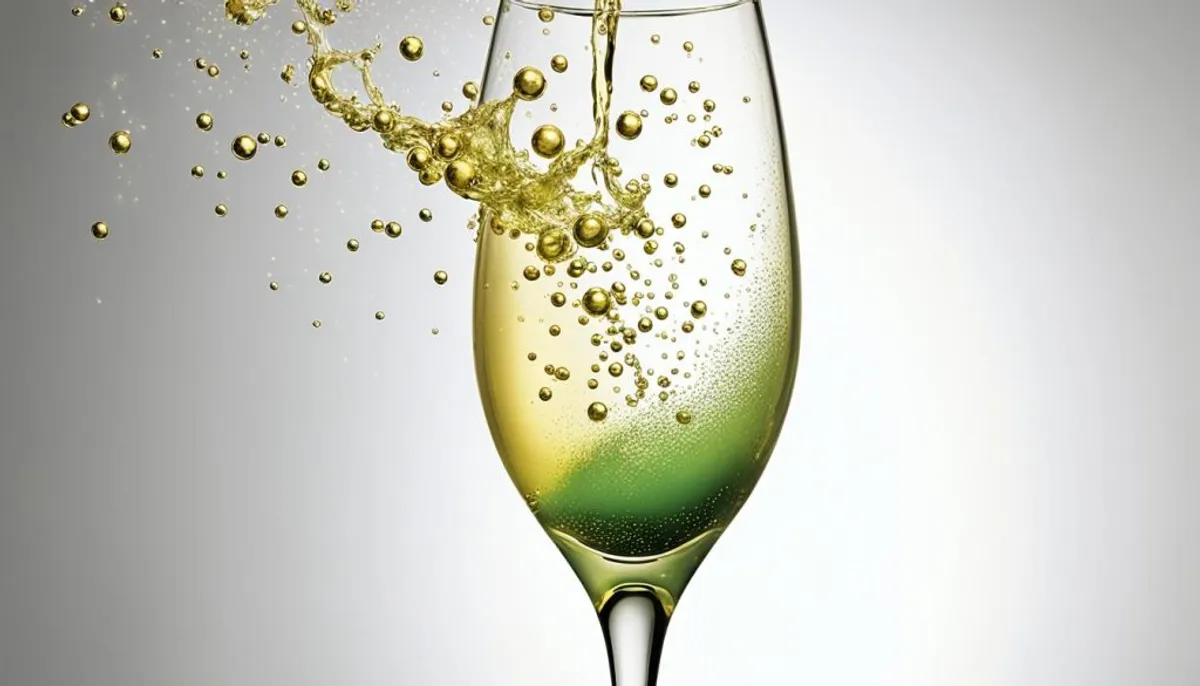Champagne is a sparkling wine that varies from bone-dry to very sweet. This range is due to the amount of residual sugar after it ferments. The sweetness is measured in terms like Brut Nature, Extra Brut, Brut, and so on. The Doux is the sweetest kind. Knowing these levels helps you pick the right one for you, whether you like dry or sweet Champagne.
Key Takeaways
- Champagne goes from very dry Brut Nature to very sweet Doux.
- Sweetness is decided by remaining sugar after fermentation.
- Knowing Champagne’s sweetness levels helps you find the best type for you.
- The sweetest kind is Doux, with more than 50 grams of sugar for each liter.
- Next is Demi-Sec Champagne, with 32-50 grams of sugar per liter.
Understanding Champagne Sweetness Levels
The sweetness in Champagne comes from the leftover sugar after making the wine. When yeast eats the sugar during fermentation, it creates bubbles. What’s left of the sugar is called residual sugar, which shows how sweet the Champagne will be.
Brut Nature and Extra Brut: The Driest Styles
Brut Nature and Extra Brut Champagnes are extremely dry. They have very little sugar, from 0-3 g/L and 0-6 g/L, respectively. These Champagnes are perfect for people who like their wine dry with almost no sweetness.
Brut: The Classic Dry Champagne
Brut Champagne is the classic dry style, with a bit more sweetness than the extra dries. It has 0-12 g/L of sugar. This makes it a great choice for anyone looking for a not too sweet, not too dry Champagne.
Extra Dry: A Hint of Sweetness
Extra Dry Champagne, or Extra Sec, has 12-17 g/L of sugar. It’s a bit sweeter than Brut but less sweet than Sec and Demi-Sec. Each 5 oz glass has 7-10 calories and 1.8–2.6 carbs. This makes it fit for many tastes.
| Champagne Style | Residual Sugar (g/L) | Calories (per 5 oz) | Carbs (per 5 oz) |
|---|---|---|---|
| Brut Nature | 0-3 | 0-2 | up to 0.15 |
| Extra Brut | 0-6 | 0-6 | up to 0.9 |
| Brut | 0-12 | 0-7 | up to 1.8 |
| Extra Dry | 12-17 | 7-10 | 1.8–2.6 |
| Sec (Dry) | 17-32 | 10-19 | 2.6–4.8 |
| Demi-Sec | 32-50 | 19-30 | 4.8–7.5 |
| Doux | 50+ | 30+ | more than 7.5 |
Extra Dry sits between Brut’s dryness and the sweeter Sec and Demi-Sec. It’s perfect for many occasions and foods, adding to its charm.
Sec (Dry): Noticeably Sweet
Sec or Dry Champagne has 17-32 g/L of sugar, making it quite sweet. It costs less than the sweeter types. Lanson’s White Label Sec offers a sweet and crisp taste without the high price.
Lanson White Label Sec: A Budget-Friendly Option
Lanson’s White Label Sec is perfect for anyone who likes sweet Champagne. It’s balanced and not too expensive. This Champagne goes well with many foods, from savory to sweet, thanks to its 17-32 g/L sugar level.
Demi-Sec: The Sweet Spot
Demi-Sec Champagne is loved by many for its sweetness. It has between 32-50 g/L of sugar, making it feel like dessert. This makes it great to enjoy with different types of food.
Armand de Brignac Demi-Sec: A Prestige Cuvée
The Armand de Brignac Demi-Sec is quite special. It combines sweetness with a rich, creamy feel. Tasting it is a lavish experience, showing the best of this Champagne type.
Billecart-Salmon Demi-Sec: Elegant and Food-Friendly
Billecart-Salmon makes a top-notch Demi-Sec Champagne. It shares its blend with their Brut Reserve but has more sugar, at 40 g/L. This makes it a perfect wine to drink with meals, offering elegance and balance.
Doux: The Sweetest Champagne
Doux Champagne is known for its sweetness, containing over 50 g of sugar per liter. It’s like having dessert in a glass. The Veuve Clicquot Rich Blanc stands out in this category, perfect for sipping alone or with mixers to boost its sweet taste.
Veuve Clicquot Rich Blanc: A Versatile Doux
The Veuve Clicquot Rich Blanc is rich, made with 60 grams of sugar per liter. It’s among the sweetest Champagnes out there. You can enjoy it straight or mix it with fresh ingredients for fancy cocktails. This makes the Veuve Clicquot Rich Blanc perfect for both casual sips and luxurious celebrations.
Which Champagne is Sweetest?
The sweetest Champagne type is Doux with over 50 g/L of sugar. It’s very sweet, like a dessert. Next sweetest is Demi-Sec (32-50 g/L), followed by Sec or Dry (17-32 g/L), and then Extra Dry (12-17 g/L). The driest Champagnes are Brut (0-12 g/L), Extra Brut (0-6 g/L), and Brut Nature (0-3 g/L).
| Champagne Style | Residual Sugar (g/L) | Calories per 5 oz Serving | Carbs per 5 oz Serving |
|---|---|---|---|
| Brut Nature | 0-3 | 91-93 | Up to 0.15 |
| Extra Brut | 0-6 | 91-96 | Up to 0.9 |
| Brut | 0-12 | 91-98 | Up to 1.8 |
| Extra Dry | 12-17 | 98-101 | 1.8-2.6 |
| Sec (Dry) | 17-32 | 101-111 | 2.6-4.8 |
| Demi-Sec | 32-50 | 111-121 | 4.8-7.5 |
| Doux | 50+ | 121+ | More than 7.5 |
Comparing it, Brut Nature Sparkling Wine has only 0.5g of sugar per 5 oz. In contrast, a Gin & Tonic has 14g, and a Starbucks 2% Milk Grande Latte has 17g.

Sweetness in Other Sparkling Wines
Champagne is not the only sweet sparkling wine out there. Moscato d’Asti comes from Italy’s Piedmont. It’s a sweet, light bubbly wine with less alcohol (about 5%). This makes it taste sweet and feel very refreshing.
Moscato d’Asti: A Sweet Italian Sparkler
Moscato d’Asti stands out for being sweet and floral. It has around 100 to 130 grams of sugar per liter. This means it’s much sweeter than many Champagnes.
And, it’s not just the taste. Moscato d’Asti is bubbly and has less alcohol. This makes it a favorite for those who enjoy a sweet, easy-drinking wine.
Pairing Sweet Champagnes
Sweet Champagnes go great with desserts, especially Demi-Sec and Doux. They match well with treats like shortbread, strawberry tartlets, and lemon meringue tarts. Even creamy desserts are a good match.
Dessert Pairings
Demi-Sec and Doux Champagnes make fruit desserts tastier. They’re perfect with peach cobbler or berry compote. The bubbly wine also keeps your mouth from feeling too sweet. For a real treat, pair Doux Champagne with chocolate cake or crème brûlée.
Savory Pairings
There’s a surprising relationship between sweet Champagnes and savory foods. Demi-Sec Champagnes work well with Roquefort cheese or spicy curries. They balance out the dishes’ richness and heat.
| Champagne Style | Residual Sugar (g/L) | Pairing Recommendations |
|---|---|---|
| Doux | 50+ | Desserts, Foie Gras, Crème Brûlée |
| Demi-Sec | 32-50 | Fruit Tarts, Cheese Plates, Seafood Dishes |
| Sec (Dry) | 17-32 | Savory Hors D’oeuvres, Spicy Cuisine |
Knowing the sweetness in Champagne helps you pair it well. This can take your meal from good to great.
The History of Sweet Champagne
In the past, champagne was sweeter to suit people’s tastes. But early in the 20th century, things changed. The makers of champagne in France faced a tough time. They lost big markets because of the Russian Revolution and Prohibition in America.
They also had vineyards damaged during the World Wars. Despite this, champagne has become more popular in modern times. Sales have gone up a lot recently.
The history of champagne runs deep. By 1661, the Benedictine Abbey at Hautvillers already had 25 acres of vineyards. This place also got grapes as gifts from nearby areas. This shows that champagne making in the region had a long tradition.
Dom Pérignon was a big deal in the world of champagne. He thought that using only Pinot noir grapes was best. He also used careful pruning to make sure the wine was of top quality.
In the 1800s, important things happened in the champagne world. A chemist, Jean-Baptiste François, figured out how to add sugar to champagne without it breaking the bottles. This meant that champagne could be made the same way every time, making production better.
By 1870, the production of champagne had grown a lot. They were making 20 million bottles, up from just 1 million. This shows how much people liked champagne.
Until the late 1800s and early 1900s, people in Europe liked sweet champagne. But this changed, and they started preferring the drier champagne style of Great Britain. In 1900, for example, people in the UK drank a big part of the world’s champagne.
Today, people often prefer drier champagnes. But there’s still love for sweet champagne. It’s enjoyed for many reasons, including its history, as a great match with food, or just because people like it.

Conclusion
Champagne comes in many sweetness levels, which means there’s something for everyone. You can choose from super dry to very sweet. This makes it easy to pick a Champagne that fits your taste.
You might love the sharp taste of Brut or enjoy the sweet Doux. There’s a lot to try. Pick what you like best, whether with food or by itself.
The great thing about Champagne is its variety. You can try different types to find your favorite. Enjoy your journey through the Champagne world.
FAQ
What determines the sweetness of Champagne?
Champagne’s sweetness comes from extra sugar after the main fermentation. This sugar’s amount decides how sweet it is.
What are the different sweetness levels in Champagne?
From very dry Brut Nature to the sweet Doux, Champagne offers many tastes. There’s also Brut, Extra Dry, Sec, and Demi-Sec in between.
What is the sweetest style of Champagne?
Doux is the sweetest style, with over 50 g/L of sugar. It tastes rich and sweet, like a dessert in a glass.
How do the other Champagne sweetness levels compare?
Then, there’s Demi-Sec, Sec (Dry), and Extra Dry, each getting a bit sweeter. The very dry ones include Brut, Extra Brut, and Brut Nature, with the least sugar.
What are some examples of sweet Champagne brands?
For sweet Champagne, try Armand de Brignac Demi-Sec, Billecart-Salmon Demi-Sec, or Veuve Clicquot Rich Blanc.
How do sweet Champagnes pair with food?
Sweet Champagnes go great with dessert. They can also pair with savory foods like strong cheese, gumbo, or curry.
Is there a history behind sweet Champagne?
Early Champagne was sweeter to match old tastes. Over time, people began to enjoy drier Champagnes more.
RelatedRelated articles



